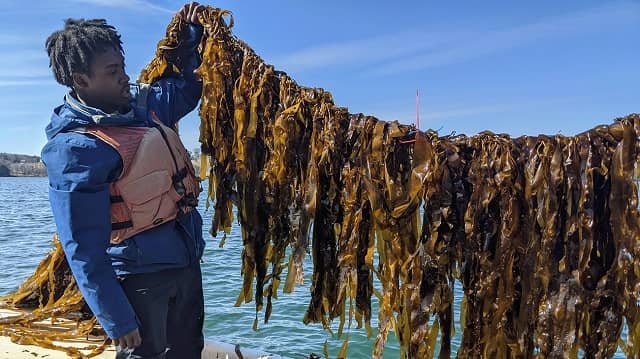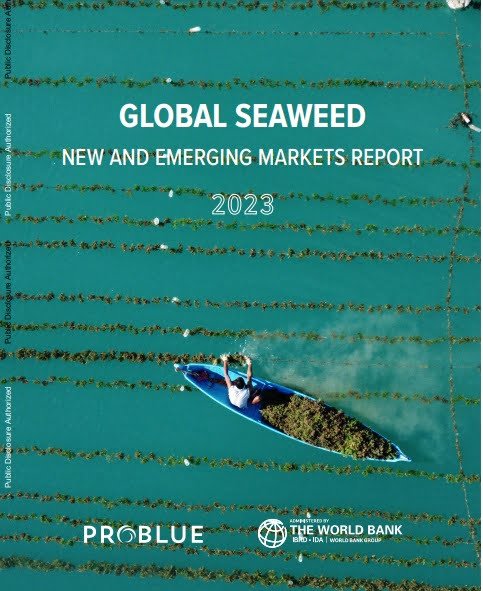
Seaweed aquaculture is a thriving industry with a market value of $11.8 billion in 2019, projected to reach $22.13 billion by 2024. Seaweed farming offers several benefits, including enhanced biodiversity, improved carbon sequestration, reduced ocean acidification, and social development opportunities.
One of the main challenges in scaling up seaweed aquaculture is the high cost of establishing infrastructure for seaweed farming. However, a proposed approach to mitigate these costs is the development of offshore aquaculture by leveraging existing infrastructure, such as offshore wind farms and decommissioned oil and gas platforms.
Researchers from Deakin University’s Centre for Marine Science and RMIT University’s Centre for Nature Positive Solutions modeled the scale of opportunity for seaweed aquaculture using existing offshore infrastructure. They explored the economic potential, key risks, and co-benefits of expanding seaweed aquaculture on offshore structures.
Opportunities in Offshore Seaweed Farming
Most seaweed aquaculture occurs near the coast, utilizing basic infrastructure and focusing on tropical species. Southeast Asia accounts for 97% of this production. However, there is growing interest in expanding offshore using existing infrastructure. The viability of this expansion depends on overcoming economic, regulatory, and environmental challenges.
According to a study published in the journal Heliyon, one major barrier to expanding offshore seaweed farming is the high cost of establishing the necessary infrastructure. Many seaweed varieties require solid surfaces for attachment.
Using existing marine infrastructure, such as wind farms and decommissioned oil and gas platforms, as anchors for seaweed farms could potentially reduce these costs. Additionally, such infrastructure provides a foundation for maintenance and monitoring activities.
Oil and gas infrastructure typically has a lifespan of 15 to 50 years, necessitating significant investment for decommissioning. Leaving the infrastructure in place and repurposing it for seaweed farming could be a more cost-effective option than removal.
The researchers noted that most oil and gas infrastructure is located in the Gulf of Mexico, while wind farms are primarily found in the North Sea. There is currently only one example of a combined wind and seaweed farm under development, and the concept of seaweed farming on decommissioned oil and gas platforms remains theoretical.
Stay Always Informed
Join our communities to instantly receive the most important news, reports, and analysis from the aquaculture industry.
The Potential of Offshore Seaweed Farming
The study examines the potential for utilizing existing marine infrastructure for seaweed aquaculture. The findings suggest that substantial areas, ranging from 53,387 to 106,774 hectares, could be used for seaweed farming in offshore wind farms, with the potential to produce between 736,831 and 4,441,116 tons of dry seaweed annually.
Decommissioned oil and gas infrastructure presents an even greater opportunity, with potential cultivation areas ranging from 1,357,530 to 5,430,120 hectares. This could result in 687,784 to 8,616,449 tons of CO2 sequestration annually. Additionally, low-carbon seaweed-based products derived from this cultivation could displace an additional 987,642 to 33,221,364 tons of CO2 emissions.
Challenges of Offshore Seaweed Farming
While the scale of opportunity is significant, there are regulatory and engineering costs associated with “keeping the lights on” for decommissioned oil and gas infrastructure, which could make seaweed farming costs prohibitively high.
Economic viability depends on developing scalable markets for high-value seaweed products and advancing research to reduce the costs of offshore aquaculture infrastructure. Trials in different locations and with various species are also needed to validate modeled yields.
Furthermore, a better understanding and minimization of ecological and regulatory risks associated with offshore seaweed farming are crucial. A substantial increase in the market value of seaweed products is necessary to make offshore infrastructure economically viable.
Conclusion
Offshore seaweed farming on existing infrastructure presents a compelling opportunity to expand seaweed production, enhance environmental benefits, and generate economic gains. However, significant challenges remain, including the economic feasibility of retrofitting decommissioned infrastructure and potential ecological risks associated with offshore seaweed farming. Further research is required to address these challenges and ensure the sustainable development of this promising field.
The study was funded by Deakin University and Sea Green Pte Ltd, with support from the Australian Research Council Discovery Project.
Contact
Finnley W.R. Ross
Centre for Marine Science, School of Life and Environmental Sciences, Deakin University
Burwood Campus, Burwood VIC, Australia
Email: fwross@deakin.edu.au
Reference (open access)
Ross, F. W., Malerba, M. E., & Macreadie, P. I. (2025). Global potential for seaweed aquaculture on existing offshore infrastructure. Heliyon, 11(1), e41248. https://doi.org/10.1016/j.heliyon.2024.e41248
Editor at the digital magazine AquaHoy. He holds a degree in Aquaculture Biology from the National University of Santa (UNS) and a Master’s degree in Science and Innovation Management from the Polytechnic University of Valencia, with postgraduate diplomas in Business Innovation and Innovation Management. He possesses extensive experience in the aquaculture and fisheries sector, having led the Fisheries Innovation Unit of the National Program for Innovation in Fisheries and Aquaculture (PNIPA). He has served as a senior consultant in technology watch, an innovation project formulator and advisor, and a lecturer at UNS. He is a member of the Peruvian College of Biologists and was recognized by the World Aquaculture Society (WAS) in 2016 for his contribution to aquaculture.




